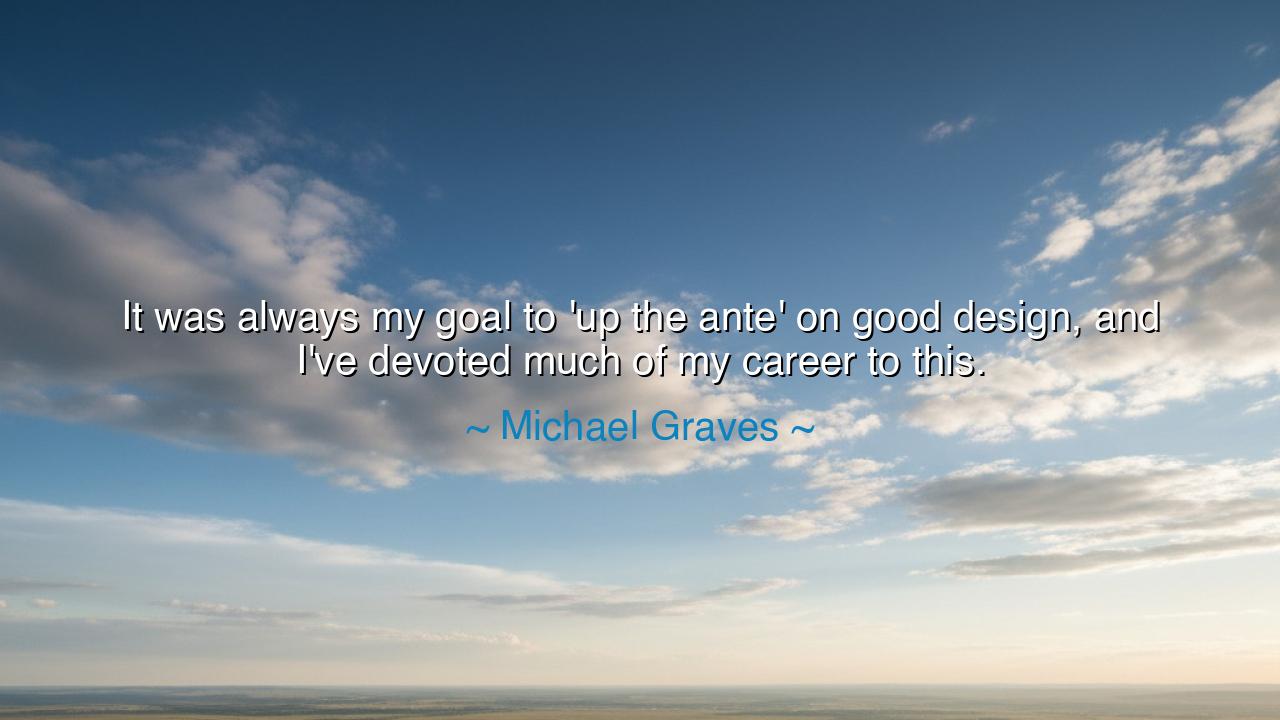
It was always my goal to 'up the ante' on good design, and I've
It was always my goal to 'up the ante' on good design, and I've devoted much of my career to this.






“It was always my goal to ‘up the ante’ on good design, and I’ve devoted much of my career to this.” Thus spoke Michael Graves, the architect, visionary, and master of form, whose works reshaped the boundary between beauty and function. In this declaration, he reveals not just a personal ambition, but a sacred calling — the unending quest to elevate design beyond the ordinary, to refine it until it reflects both intellect and soul. To “up the ante” is not merely to improve; it is to challenge the complacent, to demand more of both the creator and the creation. Graves’ words carry the flame of all great artisans who dared to look upon their world and say, “This can be made better.”
When Graves speaks of his goal, he does not speak of competition in the marketplace, but of excellence as devotion. For the artist, the craftsman, and the designer alike, to “up the ante” is to recognize that good is never enough when greatness is possible. It is to look upon a chair, a building, or a teapot and see not an object, but an opportunity — an opportunity to bring meaning, dignity, and delight to everyday life. Graves devoted his life to this pursuit. His architecture, from the bold geometry of the Portland Building to the gentle curvature of his household designs, carried the message that beauty is not luxury, but necessity — that every human deserves to live surrounded by thoughtful design.
The origin of this quote lies in Graves’ own transformation as a designer. In his early years, he was a member of the New York Five, a group of modernist architects who followed the pure geometries and strict rationalism of Le Corbusier. Yet Graves came to feel that this kind of design — austere, intellectual, stripped of ornament — failed to engage the human spirit. He sought to “up the ante” by reintroducing color, emotion, and symbolism into modern architecture, pioneering what would later be known as Postmodernism. His buildings spoke in new tongues: whimsical yet monumental, playful yet profound. Through them, he taught that design must not only function, but communicate — that it must be felt as well as seen.
This philosophy extended beyond architecture. After illness confined Graves to a wheelchair later in life, he began to design medical equipment — hospital furniture, walking aids, and tools — that were both functional and beautiful. He believed that the sick and the elderly, too, deserved surroundings that uplifted rather than diminished the human spirit. This was the purest embodiment of his quote — the refusal to accept what “works” when something that inspires could be made instead. In this, he joined the company of other great reformers: of William Morris, who fought against the soullessness of industrial production, and of Leonardo da Vinci, who found divinity in every line and proportion.
In these words, Graves offers a challenge to all creators — not only to architects, but to anyone who builds, writes, teaches, or dreams. To “up the ante” means to look at one’s craft not as a burden, but as a moral duty: to make the world a little more humane, a little more thoughtful, a little more alive. The true designer does not stop at adequacy, for adequacy serves only the moment. Excellence, however, serves the ages. When we improve what we touch, we honor those who will come after us — those who will live, work, and dream within the spaces we leave behind.
And yet, there is humility in Graves’ ambition. To seek higher ground in one’s art is not arrogance, but reverence — reverence for the human experience itself. For every act of design, whether great or small, is a conversation with life: how we live, how we move, how we connect. When Graves sought to “up the ante,” he was not chasing perfection for perfection’s sake; he was seeking to make design a reflection of humanity’s best self. His life was proof that design, rightly pursued, is not decoration — it is service.
So let this be the lesson: never settle for what merely suffices. Whether you build cathedrals or carve spoons, whether you design systems or nurture souls, strive always to “up the ante” — to bring greater care, thought, and beauty into the world around you. Ask yourself not, “Is this good enough?” but, “Does this honor the human spirit?” Let your work, like Graves’, remind others that quality and compassion can coexist, that progress need not destroy grace, and that to design well is, in truth, to love deeply.
For in every age, civilization is judged not by its monuments, but by the care it gives to its smallest details — the curve of a handle, the warmth of a room, the balance of a form. These are the silent proofs of humanity’s striving toward the divine. And so, like Michael Graves, let each of us devote our days to “upping the ante” on what is good — until the ordinary becomes extraordinary, and the world, through our hands, grows ever more beautifully designed.






AAdministratorAdministrator
Welcome, honored guests. Please leave a comment, we will respond soon